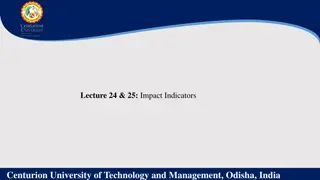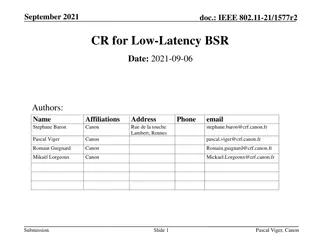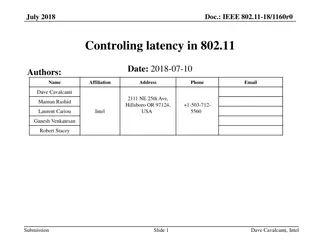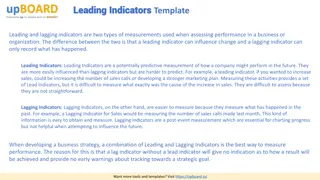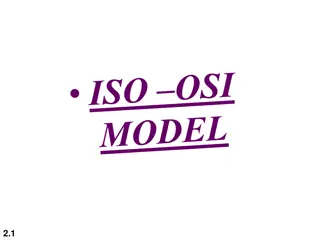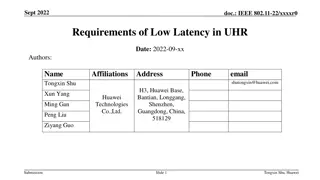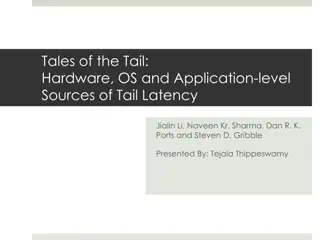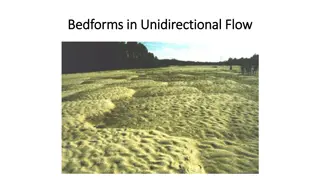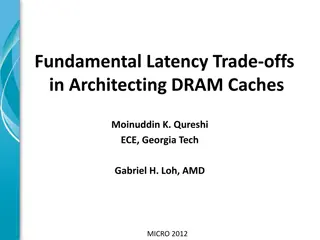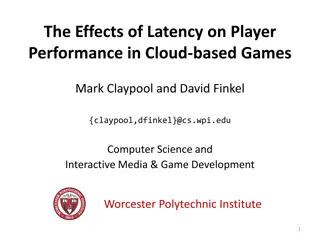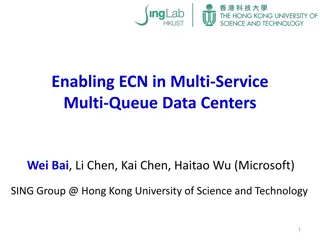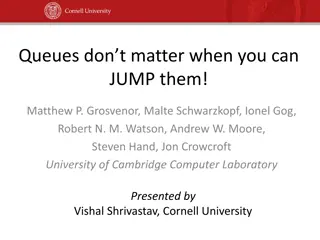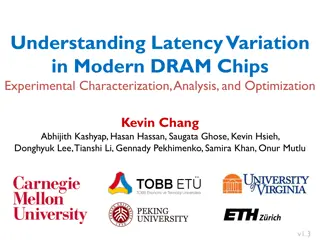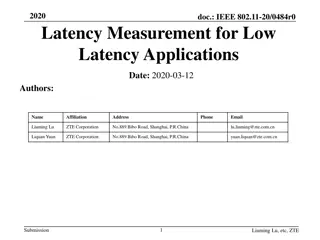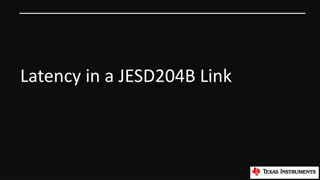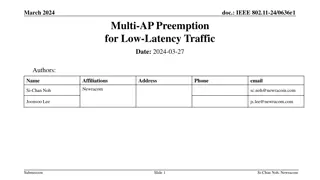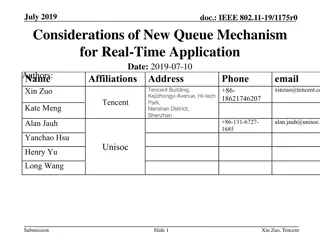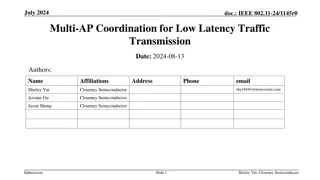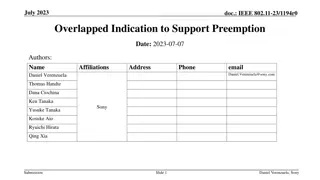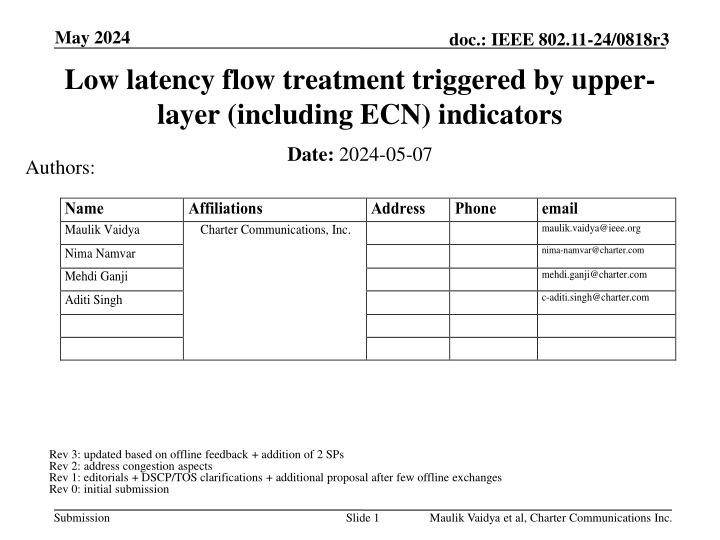
IEEE 802.11-24/0818r3: Low Latency Flow Treatment Methods
Explore the latest document from May 2024 discussing low-latency flow treatment triggered by upper-layer indicators in IEEE 802.11 networks. The document addresses distinguishing normal flows from latency-sensitive ones, indicating desired latency treatment bounds, and signaling congestion at intermediary nodes. Discover approaches to improve end-to-end latency and reduce tail latency within the IEEE 802.11 scope.
Download Presentation

Please find below an Image/Link to download the presentation.
The content on the website is provided AS IS for your information and personal use only. It may not be sold, licensed, or shared on other websites without obtaining consent from the author. If you encounter any issues during the download, it is possible that the publisher has removed the file from their server.
You are allowed to download the files provided on this website for personal or commercial use, subject to the condition that they are used lawfully. All files are the property of their respective owners.
The content on the website is provided AS IS for your information and personal use only. It may not be sold, licensed, or shared on other websites without obtaining consent from the author.
E N D
Presentation Transcript
May 2024 doc.: IEEE 802.11-24/0818r3 Low latency flow treatment triggered by upper- layer (including ECN) indicators Date: 2024-05-07 Authors: Name Maulik Vaidya Affiliations Charter Communications, Inc. Address Phone email maulik.vaidya@ieee.org nima-namvar@charter.com Nima Namvar mehdi.ganji@charter.com Mehdi Ganji c-aditi.singh@charter.com Aditi Singh Rev 3: updated based on offline feedback + addition of 2 SPs Rev 2: address congestion aspects Rev 1: editorials + DSCP/TOS clarifications + additional proposal after few offline exchanges Rev 0: initial submission Submission Slide 1 Maulik Vaidya et al, Charter Communications Inc.
May 2024 doc.: IEEE 802.11-24/0818r3 Introduction 11bn PAR includes the reduction of tail latency in its scope of the IEEE 802.11bn project [1]. Several L4S related contributions ([1]-[6], [10]) were submitted to UHR SG, ARC SC, WNG SC to illustrate efforts in IETF, CableLabs, and 3GPP to tackle end-to- end latency. The basis of most (except [6], [10]) contributions was a lean towards implementing some dual queue Active Queue Management (AQM) per [7], [8] within in 802.11 scope After various offline discussions with the involved parties, the authors understand the concerns with such an approach L4S only addresses queueing delay; does not address channel access delay. In some scenarios, channel access delay dominates. In this contribution the authors discuss approaches wherein the following aspects are explored means to distinguish between a `normal` flow vs a `latency-sensitive` flow means to indicate desired latency treatment bounds for a given flow means to signal congestion of intermediary node (AP) Submission Slide 2 Maulik Vaidya et al, Charter Communications Inc.
May 2024 doc.: IEEE 802.11-24/0818r3 Q1: Can distinguishing `normal` vs `L4S marked` packets help? (1/4) As is known ([2], [6]) for L4S to work (between sender and receiver): 1. Not all participating nodes in an e2e chain need to support L4S in its strictest (IETF RFC compliance) sense 2. All participating nodes in an e2e chain need to support carrying over ECN markings 3. L4S-supporting nodes, can apply L4S-specific flow treatments (by way of implementation of [7],[8] including setting CE (11) in ECN field if node itself is experiencing congestion) 802.11 entities (non-AP STA, AP STA) are usually only two nodes of a much longer transport network end-to-end (e2e) chain In DL direction, this means AP STA needs to potentially make certain decisions in regards to a given flow s latency treatment In UL direction, this means non-AP STA and/or AP STA need to potentially make certain decisions in regards to a given flow s latency treatment Submission Slide 3 Maulik Vaidya et al, Charter Communications Inc.
May 2024 doc.: IEEE 802.11-24/0818r3 Q1: Can distinguishing `normal` vs `L4S marked` packets help? (2/4) DL perspective (sender) (nodes) (AP STA) (non-AP STA) AP receives DSCP marked packets from its IP layers which in turn receives it from a peer node AP at minimum needs to support /2/ (from slide#3), meaning to carry over the ECN markings to the STA AP STA perspective: There can still be a direct benefit to the AP in performing actions compliant to /3/ e.g. for the case of AP experiencing congestion itself (such as due to various hardware or software issues) Both [12], [13] also corroborate that AP s own congestion should be factored in In addition, distinguishing an L4S-marked flow to that of non-L4S-marked flow could allow an AP to employ the plethora of existing latency-reduction mechanisms available in .11be PHY/MAC or (to be standardized) potential latency-reduction mechanisms in .11bn PHY/MAC (e.g. rTWT changes, DSO, non-secondary channel access etc) It wouldn t be too far-fetched to conclude that mechanism(s) which aid in identifying latency- sensitive flows (which L4S flows would be) would also fall under the purview of 802.11bn PAR [1] Non-AP STA perspective: STA IP layer will receive DL IP packet w/ IP header containing DSCP markings as done so by peer node and/or as modified by AP sender s intended payload in the data portion of IP packet Meaning, intended application (for that flow) in STA can disambiguate congestion from other losses/delays by examining IP header itself except of AP's own congestion Submission Slide 4 Maulik Vaidya et al, Charter Communications Inc.
May 2024 doc.: IEEE 802.11-24/0818r3 Q1: Can distinguishing `normal` vs `L4S marked` packets help? (3/4) UL perspective (non-AP STA) (AP STA) (nodes) (receiver) Non-AP STA receives DSCP marked packets from its IP layers which in turn receives it from application layer Non-AP STA, being the sender of L4S flow, supports /2/ and /3/ (from slide#3) AP STA, being an intermediate node, must support /2/ and may support /3/ (from slide#3). Non-AP STA perspective: Per above, here it is assumed that non-AP STA being the originator of L4S capable flow at least has L4S awareness (from L7 and below) till IP layer In theory, mechanisms for a sender to set ECN bits to CE at the source itself exist1; but in practice this is not expected In scenarios where mechanisms such as UL OFDMA or UORA and trigger-based UL transmissions are employed at 802.11 PHY/MAC layers, appropriate desired (low-latency) flow treatment to the AP can certainly aid in better air resource utilization AP STA perspective: Per above (STA perspective), reception of desired flow treatment of impending flows (which L4S flows would be) aiding in triggering of plethora of existing latency-reduction mechanisms available in .11be PHY/MAC or (to be standardized) potential latency-reduction mechanisms in .11bn PHY/MAC (e.g. rTWT changes, DSO, non-secondary channel access etc) would also fall under the purview of 802.11bn PAR [1] 1: https://github.com/L4STeam/linux Submission Slide 5 Maulik Vaidya et al, Charter Communications Inc.
May 2024 doc.: IEEE 802.11-24/0818r3 Q1: Can distinguishing `normal` vs `L4S marked` packets help? (4/4) Conclusion The authors propose that the presence of L4S-marked packets (from upper layers) can serve as one of many criteria which can be used to determine and apply various current/future (in context of .11bn) 802.11-specific low- latency treatments low-latency treatment for flows with ECN marking in IP header does not mean implement L4S (per IETF RFCs) at 802.11 PHY/MAC Subsequently, the authors explore a few ways of enabling the above Submission Slide 6 Maulik Vaidya et al, Charter Communications Inc.
May 2024 doc.: IEEE 802.11-24/0818r3 Q2: How to distinguish between `normal` vs `L4S marked` packets? (1) 8-bit TOS / Traffic Class field in IPv4 / IPv6 header comprising of 6-bits of DSCP provide information regarding expected classification and treatment of IP packet 2-bits are Explicit Congestion Notification (ECN) (re)used to provide L4S s end-to-end flow treatment 2-bit value 00 01 10 11 Meaning Not ECN-Capable Transport, Not-ECT ECT-capable transport, ECT(1) ECT-capable transport, ECT(0) Congestion Experienced Submission Slide 7 Maulik Vaidya et al, Charter Communications Inc.
May 2024 doc.: IEEE 802.11-24/0818r3 Q2: How to distinguish between `normal` vs low- latency (including `L4S marked`) packets? (2) Two broad frameworks within [9] provide consumption of various properties and expectations of application-generated flows by upper-layers (to U-MAC) a. (Application layer ) User Priorities Access Categories mapping b. Stream Classification Service (SCS) introduced in 802.11aa Previous contributions (e.g. [6]) have already presented thoughts in or around applicability of /a/. Few issues: Aspects of /a/ are implementation dependent i.e. there may be a large variance in say 802.11be AP implementation by vendor X vs vendor Y: (i) understand the characteristics of the same application flow (say streaming live video) in the same manner and (ii) apply appropriate flow treatment (including scheduling priorities) Submission Slide 8 Maulik Vaidya et al, Charter Communications Inc.
May 2024 doc.: IEEE 802.11-24/0818r3 Q2: How to distinguish between `normal` vs low- latency (including `L4S marked`) packets?(3) /b/ largely deals with {AC_VO, AC_VI} types of flows Modern day application flows are increasingly hard to bucketize (by virtue of its packet delay budget, jitter requirements etc c.f. [6]) in such limited number (4,6,8) categories of flow treatments But, SCS framework does provides a slightly more flexible way (compared to /a/) to consume desired per-flow treatment between STAs and APs Means to relay TCP/IP-related parameters is also provided via SCS Descriptor TCAS Frame Classifier Classifier Type (value = 1,4) However, typically it is flows corresponding to {AC_BE, AC_VI} which are prone to queue-building ([2], [4], [6]) in intermediary or final nodes of an e2e chain Also, employment of SCS in an AP or STA is governed by dot11RobustAVStreamingImplemented (c.f. [9] 11.25.1) which in turn is dictated by voice and/or data related flows; not necessarily e.g. gaming. Furthermore, ECN bits are not presently conveyed in TCAS! Hence, the use of SCS to cover non-video type queue-building traffic flows may not be covered adequately. Submission Slide 9 Maulik Vaidya et al, Charter Communications Inc.
May 2024 doc.: IEEE 802.11-24/0818r3 Q2: How to distinguish between `normal` vs low- latency (including `L4S marked`) packets? (4) Proposal 1: One potential realization of the desired behavior could be by virtue of introduction of a new SME parameter e.g. dot11LLbasedTreatment which serves to group various low-latency specific (.bn) treatments that could be applied based on numerous criteria (including identification of required flows QoS characteristics see next slide): gets set at non-AP or AP STA when dot11RobustAVStreamingImplemented is supported and .11bn-specific latency mechanisms can be employed (including consumption of L4S markings for flows belonging to {AC_BE, AC_VI}) which may warrant introduction of a new transmit queue for {AC_BE}e.g.{A_BE};if so, then it will be in addition to the other two alternate queues {A_VO, A_VI} gets exchanged between non-AP and AP STA at the time of non-AP STA s association mutual support will serve to activate mechanisms which aim to identify desirable flow treatment (see next slide), and/or employ existing latency-reduction mechanisms available in .11be PHY/MAC or (to be standardized) potential latency-reduction mechanisms in .11bn PHY/MAC (e.g. rTWT changes, DSO, non-secondary channel access etc) Submission Slide 10 Maulik Vaidya et al, Charter Communications Inc.
May 2024 doc.: IEEE 802.11-24/0818r3 Q2: How to distinguish between `normal` vs low- latency (including `L4S marked`) packets? (5) Proposal 2: Another potential realization of the desired behavior could be by virtue of introduction of a new SME parameter e.g. dot11LLbasedTreatment which serves to group various low-latency specific (.bn) treatments that could be applied based on numerous criteria (including identification of required flows QoS characteristics see next slide): gets set at non-AP or AP STA when dot11RobustAVStreamingImplemented is supported and dot11AlternateEDCAActivated is set to false, then {A_VO, A_VI} act as L4S (dual AQM) queues gets exchanged between non-AP and AP STA at the time of non-AP STA s association mutual support will serve to activate mechanisms which aim to identify desirable flow treatment (see next slide), and/or employ existing latency-reduction mechanisms available in .11be PHY/MAC or (to be standardized) potential latency-reduction mechanisms in .11bn PHY/MAC (e.g. rTWT changes, DSO, non-secondary channel access etc) This proposal is similar to section A of [12] Submission Slide 11 Maulik Vaidya et al, Charter Communications Inc.
May 2024 doc.: IEEE 802.11-24/0818r3 Q3: How to indicate desired latency treatment for a given flow? (1/2) Present-day SCS framework does still lack the ability to convey application flow characteristics to/from STA and AP Understandably so as it seems the design intent for SCS was slightly different There can be two approaches to bridging such a gap Approach 1: Specify and signal a bitmap mask such that each value of the mask refers to fixed QoS traits (e.g. jitter, packet delay budget, packet error rate, averaging window, tolerable end to end latency etc) Easier to manage but difficult to scale to accommodate needs of future types of traffic Approach 2 (preferred): Indicate desirable QoS traits either prior to or along with flow transmission Cumbersome signalling but can prove very flexible to accommodate needs of future types of traffic Next slides illustrate a high-level sketch of two potential solutions following this approach Submission Slide 12 Maulik Vaidya et al, Charter Communications Inc.
May 2024 doc.: IEEE 802.11-24/0818r3 Q3: How to indicate desired latency treatment for a given flow? (2/3) Proposal 1: Client-driven filter setup: Assuming a positive answer to Q1 with a baseline solution from slide#10, in one proposed solution: STA can indicate traffic characteristics (via Latency Descriptor Element shown below) expected for a given flow (based on the expectation of triggering or receiving application e.g. a cloud-gaming application). (Non-exhaustive) Information such as below can be included: ECN (from IP header):ECN bits (including L4S support) are not presently conveyed. ECN Threshold: Defines the congestion level at which the client starts sending ECN signals. Latency Target: Specifies the desired maximum delay for a given traffic flow. Loss Tolerance: Defines the acceptable packet loss rate for a given traffic flow. Desired Bandwidth: Indicates the preferred minimum bandwidth allocation (in e.g. kbps) for a given traffic flow. Above information can be included in a new element as part of SCS request frame AP can perform appropriate treatment resource allocation treatment available to it (e.g. change rTWT, non-secondary channel access etc) SCS Request Frame: Category Robust Action Dialog Token SCS Descriptor List SCS Descriptor Element: Intra-AC Priority Element (opt.) TCLAS TCLAS Processing Element (opt.) Latency Descriptor Element Length SCSID Element ID Request Type Element (opt.) Submission Slide 13 Maulik Vaidya et al, Charter Communications Inc.
May 2024 doc.: IEEE 802.11-24/0818r3 Q3: How to indicate desired latency treatment for a given flow? (3/3) Proposal 2: Extend 802.11be [11] QoS: Assuming a positive answer to Q1 with a baseline solution from slide#10, in one proposed solution: Stream Classification Service (SCS) was enhanced in P802.11be with additional QoS Characteristics for time-sensitive traffic flows, which enables a direct mapping of scheduling requirements from 802.1Qbv to the 802.11 MAC Even though the original design focused on time-sensitive flows, the mechanism can be applied to convey additional application-specific latency characteristics of a given flow Similar to Proposal 1, an STA may indicate additional traffic characteristics (via Latency Descriptor Element shown below) expected for a given flow (based on the expectation of triggering or receiving application e.g. a cloud-gaming application). (Non-exhaustive) Information such as below can be included: ECN (from IP header):ECN bits (including L4S support) are not presently conveyed. ECN Threshold: Defines the congestion level at which the client starts sending ECN signals. Latency Target: Specifies the desired maximum delay for a given traffic flow. Loss Tolerance: Defines the acceptable packet loss rate for a given traffic flow. Desired Bandwidth: Indicates the preferred minimum bandwidth allocation (in e.g. kbps) for a given traffic flow. Signalling means to accommodate the addition (including capability exchange) will also need to be specified AP can then perform appropriate treatment resource allocation treatment available to it (e.g. change rTWT, non- secondary channel access etc) (c.f. [11] Fig 9-1001au ) QoS Characteristics Element: Minimum Service Interval Mnimum Service Interval Minimum Data Rate Delay Bound . Latency Descriptor Element Length Element ID Element ID Extension Control Info Submission Slide 14 Maulik Vaidya et al, Charter Communications Inc.
May 2024 doc.: IEEE 802.11-24/0818r3 Q4: What if AP experiences congestion in downlink? (1) Per slide#4, in the downlink AP s MAC layer may receive flows, from IP layer, without CE(11) marking no intermediary node experienced congestion thus far But AP itself may itself experience, for varied reasons e.g. due to various hardware or software issues, congestion etc Presently done via vendor-implementation means Irrespective of whether L4S queues are implemented In this case, the ECN bits in the IP header of subsequent flows to indicate CE (11) is required Doing so becomes important in order to support end-to-end L4S Hence, vendor-implementation based approach no longer suffices; a standardized mechanism of doing so is required Various solutions are proposed in [12], [13] which can be broadly classified into two categories: Approach 1: Modifications across the MAP-SAP boundary to allow communicate AP to communicate said congestion Approach 2: Modifications across the MAP-SAP boundary on both AP and STA, along with AP-to-STA signalling change (@L2) to facilitate STA MAC to absorb the change Submission Slide 15 Maulik Vaidya et al, Charter Communications Inc.
May 2024 doc.: IEEE 802.11-24/0818r3 Summary and Conclusions A rationale for distinguishing between normal vs latency- sensitive flows using criteria such as upper-layer L4S markings (in ECN field of IP header) is introduced followed by different means to indicate desired latency treatment bounds for a given flow followed by different means to signal congestion of intermediary node (AP) in downlink Submission Slide 16 Maulik Vaidya et al, Charter Communications Inc.
May 2024 doc.: IEEE 802.11-24/0818r3 Straw Poll#1 (SP1) Do you agree to optionally define a new mechanism in 802.11bn which allows consideration of ECN bits from IPv4/v6 header (TOS/Traffic Class fields), at the MAC layer, for handling traffic flows with QoS requirements, at both AP and non-AP STAs NOTE 1 The exact mechanism is TBD NOTE 2 Proposals introducing new MAC frames will not be considered as in- scope for this feature NOTE 3 Proposals which modify existing fields or introduce new fields are considered as in-scope for this feature Submission Slide 17 Maulik Vaidya et al, Charter Communications Inc.
May 2024 doc.: IEEE 802.11-24/0818r3 Straw Poll#2 (SP2) Do you agree to define a new (optional) mechanism in 802.11bn which allows the MAC layer to indicate, to higher layers at the MAC-SAP boundary, the condition of congestion experienced (at or below MAC layer) to facilitate appropriate ECN markings (by higher layers) for subsequent IP v4/v6 packets NOTE 1 The exact mechanism is TBD NOTE 2 The condition of Congestion Experienced includes scenarios leading to a build-up of queues (at MAC and/or PHY layer) due to variety of reasons including delays in accessing channel resulting NOTE 3 Proposals which modify ECN treatment of IPv4v/6 flows existing in MAC queues are out of scope Submission Slide 18 Maulik Vaidya et al, Charter Communications Inc.
May 2024 doc.: IEEE 802.11-24/0818r3 References 1. 2. 3. 4. 5. 6. 7. 8. 9. 10. 11-24-0080-01-0arc-l4s-over-wi-fi-links 11. 802.11be Draft 4.0 12. 11-24-0399-00-00bn-thoughts-on-l4s-in-wi-fi 13. 11-24-0384-02-00bn-low-latency-based-on-l4s 802.11bn PAR 11-23-2065-00-0wng-l4s-and-implications-for-wi-fi 11-24-0080-01-0arc-l4s-over-wi-fi-links 11-23-0679-00-0uhr-low-latency-qos-based-on-l4s 11-23-0034-01-ICne-congestion-signaling-csig 11-23-0650-01-qoS-revisited IETF RFC 9330 IETF RFC 9331 802.11Rev me Draft 4.1 Submission Slide 19 Maulik Vaidya et al, Charter Communications Inc.

